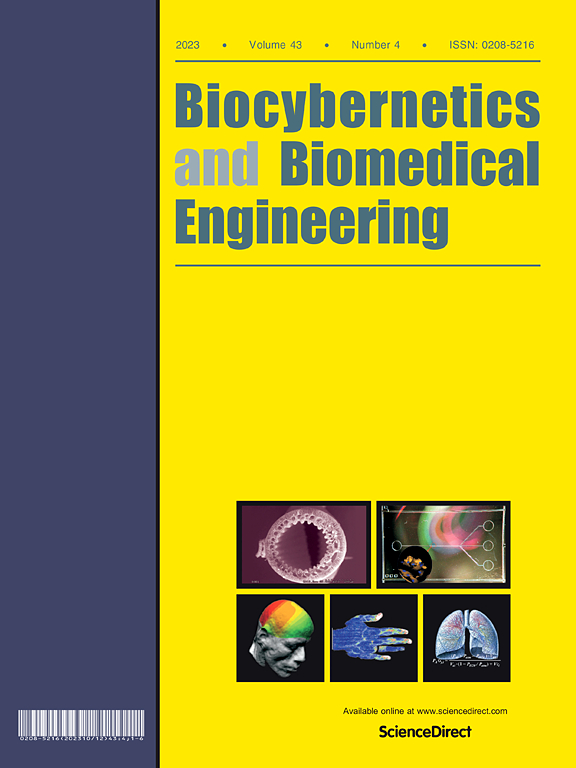非线性相关指标能否监测大脑自调节?概念验证研究
IF 6.6
2区 医学
Q1 ENGINEERING, BIOMEDICAL
引用次数: 0
摘要
目的脑自调节(cerebral autoregulation, CA)是脑血管自我调节血流以维持脑灌注的机制。虽然CA监测被推荐用于神经危重症监护,作为改善治疗的一种手段,但目前对于最有效的计算技术还没有达成共识。本研究的目的是评估使用递归量化分析(RQA)(一种分析复杂系统的非线性方法)作为传统的基于线性相关指标的替代方法来测量CA的可行性。方法回顾性分析在神经危重症监护室治疗的出现自发性颅内压升高(高原波)的颅脑损伤患者的数据库。来自动脉血压、ICP和脑血流速度的信号被划分为ICP升高(与CA恶化相关)的稳定阶段和之前的基线。计算两个时期的非线性RQA相关性,并对结果进行统计学比较。作为参考,已建立的线性CA指数以相同的方式进行评估。结果非线性相关性遵循与线性CA指数相似的模式,并成功区分了高原波相位,具有相当的高水平统计学意义(p <;0.0001),同时显示出更高的值和减少的数据分散。结论非线性RQA相关性评价CA是可行的。据作者所知,这是CA研究中首次对RQA可行性进行评估。在追求一个可靠的指标,适合在神经危重症护理的广泛实施,非线性的方法可能提供一个有希望的替代传统的线性相关为基础的指标。本文章由计算机程序翻译,如有差异,请以英文原文为准。
Can cerebral autoregulation be monitored with non-linear correlation indices? A proof-of-concept study
Objective
Cerebral autoregulation (CA) is the mechanism by which cerebral vessels self-regulate blood flow to maintain adequate brain perfusion. Although CA monitoring is recommended in neurocritical care as a means to improve therapy, there is currently no consensus on the most effective computational technique. The aim of this study was to evaluate the feasibility of measuring CA using recurrence quantification analysis (RQA)—a non-linear method for analysing complex systems—as an alternative to traditional, linear correlation-based indices.
Methods
A retrospective analysis was conducted on a database of head-injured patients treated in a neurocritical care unit who developed spontaneous intracranial pressure (ICP) elevations known as plateau waves. Signals from arterial blood pressure, ICP, and cerebral blood flow velocity were segmented into stable phases of elevated ICP (associated with CA deterioration) and the preceding baseline. Non-linear RQA correlations were calculated for both periods, and the results were statistically compared. For reference, well-established linear CA indices were assessed in the same manner.
Results
The non-linear correlations followed a similar pattern to the linear CA indices and successfully differentiated the plateau wave phase with a comparable, high level of statistical significance (p < 0.0001), while demonstrating higher values and reduced data dispersion.
Conclusion
Non-linear RQA correlation is feasible for CA assessment. To the best of the authors’ knowledge, this is the first evaluation of RQA feasibility in CA research. In the pursuit of a reliable index suitable for widespread implementation in neurocritical care, a non-linear approach may offer a promising alternative to traditional linear correlation-based indices.
求助全文
通过发布文献求助,成功后即可免费获取论文全文。
去求助
来源期刊

Biocybernetics and Biomedical Engineering
ENGINEERING, BIOMEDICAL-
CiteScore
16.50
自引率
6.20%
发文量
77
审稿时长
38 days
期刊介绍:
Biocybernetics and Biomedical Engineering is a quarterly journal, founded in 1981, devoted to publishing the results of original, innovative and creative research investigations in the field of Biocybernetics and biomedical engineering, which bridges mathematical, physical, chemical and engineering methods and technology to analyse physiological processes in living organisms as well as to develop methods, devices and systems used in biology and medicine, mainly in medical diagnosis, monitoring systems and therapy. The Journal''s mission is to advance scientific discovery into new or improved standards of care, and promotion a wide-ranging exchange between science and its application to humans.
 求助内容:
求助内容: 应助结果提醒方式:
应助结果提醒方式:


